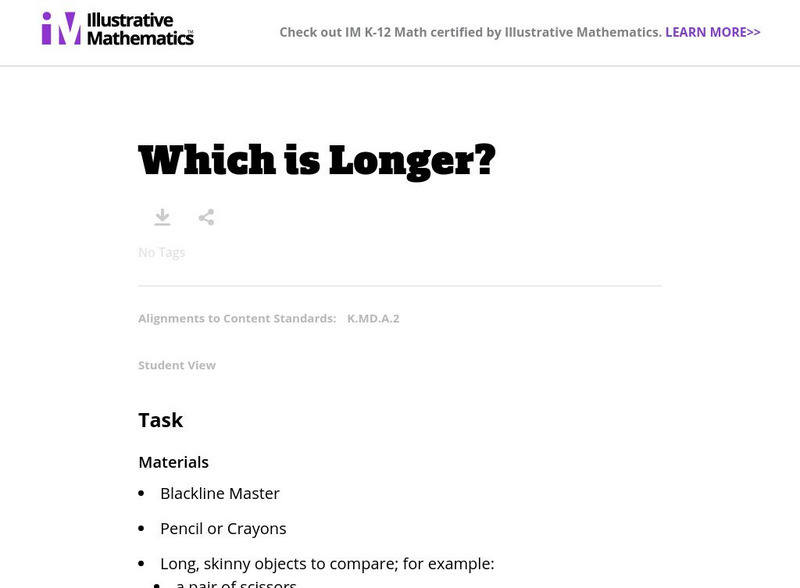Museum of the American Revolution
Object Observation: Purpose on a Powder Horn?
Young archeologists discover the significance of ordinary objects from the past in an interesting lesson on artifact analysis. The activity focuses on examining the image of a powder horn from the Revolutionary War to understand what it...
Museum of the American Revolution
Historical Analysis: Objects Tell Stories
Dig this! Young archeologists discover what objects teach us about the past. The activity uses an image of a Revolutionary War artifact to help historians practice analyzing the past. Scholars study the object and complete a worksheet to...
Center for Learning in Action
Introduction to the States of Matter
Liquids, gases, and solids are the states of matter in which scholars investigate in a lesson plan that offers in-depth information and engaging activities that look into the three states and the changes their properties make when mixed...
Curated OER
K-5 Mathematics Module: Number and Number Sense
Reinforce number sense with a collection of math lessons for kindergarteners through fifth graders. Young mathematicians take part in hands-on activities, learning games, and complete skills-based worksheets to enhance proficiency...
National Nanotechnology Infrastructure Network
Taking a Closer Look at Objects
Take a close look at the world around you with an activity that magnifies everyday objects. Five explorations examine items under intense magnification and pose a series of questions that encourage critical thinking and following...
Center for Learning in Action
Properties of Balls
Enhance your states of matter lessons with a hands-on science investigation that compares six different balls' color, texture, size, weight, ability to bounce, and buoyancy.
Curated OER
Volcanoes: Fifth Grade Lesson Plans and Activities
Fifth graders explore volcanoes and the rocks they produce using the Internet. The lab portion of the lesson prompts young scientists to compare and describe igneous rocks. Next, they critique a pair or more of...
K12 Reader
Using Similes
Your class will find using similes as easy as pie after completing this figurative language exercise. Provided with a list of incomplete similes, young writers must use their creativity to fill in the blanks with nouns that accurately...
One Billion
Math, Age 3-5
Jump start children's math education with this fun basic skills resource. Offering dozens of different touch-and-swipe activities with colorful graphics, this program is perfect for all young learners.
Illustrative Mathematics
Longer and Heavier? Shorter and Heavier?
For many young children it seems obvious that longer objects are heavier than shorter objects. This assumption is put to the test as the class investigates the relationship between length and weight in a whole-group activity. Using a...
Dorling Kindersley
Short, shorter, shortest
Supplement your lesson on comparing objects with a short and simple activity. Focusing on the words short, shorter, and shortest, children draw and circle pictures to demonstrate their understanding of these terms. As an extension...
Curated OER
Weight and Length Measurement Guided Lesson
This only has three problems, so consider simply projecting it and doing it with the whole class. First, they examine two baseball bats and circle the shorter one. Then, they consider which of two containers will hold more. Finally,...
Curated OER
Reading Venn Diagrams
Venn diagrams are useful in so many ways. The class views a worksheet to assist them in understanding how to compare two items based on similarities and differences. Children compare four different items using partially completed Venn...
Curated OER
Simple Machines in the Home
Young scholars explore simple machines used in the home. In this simple machines lesson, students discover that many household items are constructed from simple machines. Young scholars interact with nutcrackers, peelers, egg slicers,...
Curated OER
Comparing Objects
In this comparing objects worksheet, students complete multiple choice questions where they choose the correct answer for the size of the object asked. Students complete 4 problems.
Curated OER
Space Objects That Are Different
In this space objects that are different worksheet, students look at the space related pictures in each of three rows and circle the one that is different.
Curated OER
Ordering By Length
In this ordering by length worksheet, students with a partner study and analyze different ways to understand the concept of length better through comparing objects and pictures.
Curated OER
Let's Compare Cars!
In this printing practice worksheet, students first draw and color two different cars to help them compare different objects. Students then practice their printing skills as they write answers to several questions about the cars.
Curated OER
Adjectives
In this adjectives ESL instructional activity, students analyze 7 pictures that compare 2 different objects. One of the objects has an arrow pointing to it. Students match the picture with the adjective that best describes the indicated...
Illustrative Mathematics
Illustrative Mathematics: Which Is Longer?
Students are introduced to the concept of length with this hands-on activity. Each student will choose two objects to compare by laying them next to each other and comparing which is longer. Students will record and discuss their findings.
Illustrative Mathematics
Illustrative Mathematics: Longer and Heavier? Shorter and Heavier?
Students will compare the length and weight of several pairs of objects to learn that weight and length are separate measurable attributes, and not always related.
National Council of Teachers of Mathematics
Nctm: Figure This: Archeology
Site A! Site B! How alike are we? Using the information from the chart, which two dig sites seem to be most alike?
The Franklin Institute
The Franklin Institute: Classified
At this site from The Franklin Institute you can practice classifying objects according to physical structure and characteristics.





















